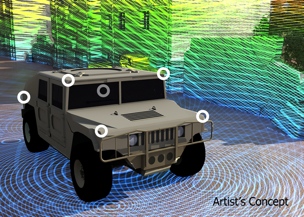Artist’s concept drawings for SWEEPER technology.
The Defense Advanced Research Projects Agency (DARPA) is the arm of the US Department of Defense that develops emerging technologies for American military use. They’re responsible for a crazy number of impressive modern tech, including a precursor to the internet, multiple kinds of robots, UAV aircraft carriers, space transport vehicles, and remote-controlled insects. They’ve also been working on LiDAR technologies for a while. Last week, they announced what might be their biggest LiDAR innovation yet.
The innovation comes from their Short-range Wide-field-of-view Extremely agile Electronically steered Photonic EmitteR (SWEEPER) program. The technology they’ve developed sounds about as complicated as that acronym, but the gist is this: they integrated laser-scanning technology onto a a silicon microchip.
Putting a LiDAR device on a microchip overcomes what DARPA calls the technology’s primary Achilles’ heel: “They require mechanical assemblies to sweep the laser back and forth. These large, slow opto-mechanical systems are both temperature- and impact-sensitive and often cost tens of thousands of dollars each–all factors that limit widespread adoption of current technologies for military and commercial use.”
By freeing LiDAR from the mechanical mount and gimbal system that is commonly used in commercial scanners, the SWEEPER team has developed a LiDAR device that can sweep a laser more than 100,000 times per second. They claim that this is “10,000 times faster than current state-of-the-art mechanical systems.”
In other words, they’ve built LiDAR tech that can withstand impact better and deal with a wider range of temperatures. It’s also much faster than existing devices, which could help open up some more handheld uses, and more uses that are intrinsically safe for the oil & gas industry. It’s also very inexpensive.
“By finding a way to steer lasers without mechanical means, we’ve been able to transform what currently is the largest and most expensive part of laser-scanning systems into something that could be inexpensive, ubiquitous, robust and fabricated using the same manufacturing technology as silicon microchips,” said Josh Conway, DARPA program manager in a statement. “This wide-angle demonstration of optical phased array technology could lead to greatly enhanced capabilities for numerous military and commercial technologies, including autonomous vehicles, robotics, sensors and high-data-rate communications.”
Its main limitations are its 51-degree range and the extreme precision required for manufacturing.
For those who follow the bleeding edge of LiDAR tech, this probably sounds similar to a technology developed by CalTech and announced two months ago. A team there also built LiDAR devices that could fit on a silicon microchip. CalTech’s device ALSO works without any mechanical parts, and promises to revolutionize 3D scanning by making the hardware very inexpensive and easy to implement.
It’s good to see a number of groups working on the technology, as it indicates a chance that the industry may seem some commercial implementations of these scanning technologies in the near future.
For more details on the project, check out DARPA’s statement.
And here’s more information on the E-PHI project, which includes the SWEEPER project.






